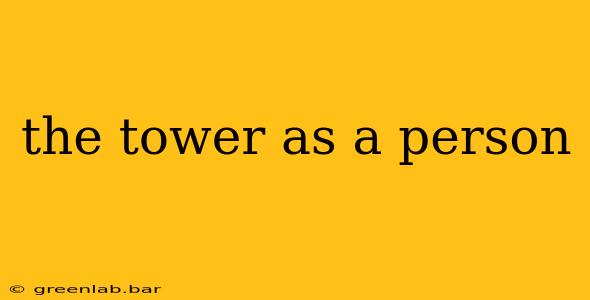The Tower, a potent symbol found across cultures and mythologies, transcends its literal architectural representation. When we consider "the tower as a person," we unlock a rich tapestry of psychological and spiritual interpretations, revealing a complex and often contradictory character. This individual embodies both immense power and profound vulnerability, mirroring the inherent duality of human existence.
The Tower's Defining Characteristics: A Psychological Portrait
Imagine the Tower personified. What traits would define them? Several key characteristics emerge from analyzing the symbolism associated with towers throughout history:
1. Imposing Height and Untouchable Grandeur:
The Tower-person is undeniably imposing. Their presence commands attention, radiating an aura of authority and inaccessibility. They may be aloof, even arrogant, owing to their perceived superiority and the distance they maintain from others. This reflects the tower's physical height and its often fortified, seemingly impenetrable nature.
2. Strength and Resilience:
Towers endure storms and stand firm against adversity. The Tower-person reflects this resilience. They possess unwavering strength, capable of withstanding immense pressure and weathering life's challenges. This strength, however, can manifest as rigidity and an unwillingness to adapt or compromise.
3. Isolation and Loneliness:
Despite their imposing stature, the Tower-person often experiences profound isolation. Their elevated position separates them from the everyday world, leading to loneliness and a sense of detachment. This mirrors the physical isolation of a tower, often situated apart from the bustling activity of daily life. The height brings a privileged view but also a profound sense of separation.
4. Vulnerability and Unexpected Collapse:
Paradoxically, despite their strength, the Tower-person carries a latent vulnerability. The very height that grants them power also makes them susceptible to sudden collapse. This vulnerability is often hidden beneath a façade of invulnerability, making their eventual downfall all the more dramatic. This speaks to the fragility of power and the unpredictability of fate.
5. Witness to History and Change:
The Tower-person has a unique perspective, acting as a silent observer of the world's unfolding drama. They bear witness to the passage of time, the rise and fall of civilizations, and the relentless cycle of change. This speaks to a depth of experience and a potential for wisdom, though not necessarily compassion or empathy.
The Tower in Mythology and Literature: Embodied Personalities
Numerous examples from mythology and literature further illuminate the Tower-person's multifaceted nature:
- The Tower of Babel: This biblical story depicts ambition run amok, highlighting the Tower-person's potential for hubris and the devastating consequences of unchecked ego.
- Rapunzel's Tower: Here, the tower symbolizes confinement and isolation, representing the Tower-person's potential for both self-imposed and externally imposed limitations.
- Fairy Tales: Many fairy tales feature towers as symbols of both enchantment and danger, highlighting the duality inherent in the Tower-person's character.
Understanding the Tower-Person: A Path to Self-Reflection
Exploring "the Tower as a person" isn't just a literary exercise; it's a powerful tool for self-reflection. By examining the qualities associated with the Tower-person, we can gain valuable insights into our own strengths, weaknesses, and vulnerabilities. Do we identify with the imposing strength or the underlying vulnerability? Understanding this duality is crucial to personal growth and achieving a more balanced and fulfilling life. The Tower, in its human form, serves as a potent reminder of the complexities within us all.

